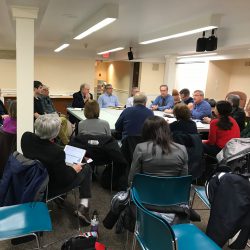Frequently Asked Questions
Where is the project?
The project is on a 2.5-mile stretch of NYS Route 96 (East Avenue) between St. John Fisher College and Highland Ave. Extension.
What is NYS DOT proposing to do?
The stretch of roadway is due to be resurfaced and painted with a new roadway configuration. Instead of four travel lanes – two in each direction – the new configuration will have two travel lanes and one center turn lane, commonly known as a “road diet.”
I’m not sure a “road diet” is a good idea. Why do you favor it?
Road diets are a proven way to make roadways safer. Motorists who are accustomed to using East Avenue to commute into the city are invited to use I-490, which is designed to accommodate a much higher volume of traffic at a higher rate of speed.
Additionally, NYS DOT does not have a choice in implementing a road diet. Per their guidelines, the traffic volume on East Avenue does not justify the current roadway configuration.
Why is this issue so important?
East Avenue is the main thoroughfare connecting the city and eastern suburbs including Brighton and Pittsford. Two colleges – St. John Fisher and Nazareth College – both are on one end of the project. Reconfiguring East Avenue to be friendlier to all users of the roadway – pedestrians, cyclists and motorists alike – is compatible with Brighton and Pittsford’s goals to increase the flexibility of their infrastructure and make it more environmentally friendly.
How is this project related to climate change?
Enabling alternatives to motor vehicle travel is intrinsic to reduction of the greenhouse gas emissions that are responsible for climate change.
NYS DOT has come partway in reducing the originally-planned travel lane widths. Why are they resisting this proposal?
NYS DOT’s highway design guide stipulates a minimum lane width of 11 feet for two-way center turn lanes. With a 40-foot roadway, an 11-foot center turn lane does not make room for 5-foot bike lanes. NYS DOT will need an exemption to build the roadway with three 10-foot lanes and two 5-foot bike lanes.
Why not implement a bike lane going in one direction?
We anticipate bicyclists will want to “commute” between the city and the eastern suburbs. Whether heading from a city apartment to college at St. John Fisher or Nazareth, or heading from the suburbs into the city to enjoy its amenities, cyclists will want a return route.
Why aren’t 4.5-foot shoulders sufficient?
In the absence of a properly-demarcated bike lane, motorists don’t have as much incentive to avoid shoulder incursions. Furthermore, federal regulations require a 5-foot right of way for a bicycle lane to be demarcated with the familiar bicycle logo stenciled into the roadway.
Aren’t bicyclists required to use bike lanes if available? What if an obstruction forces them into the roadway?
Although bicyclists are required to use bike lanes if available, state law explicitly provides for them to depart the bike lanes for their safety or when there is an obstruction.
Why are you being so insistent? It seems the new roadway will be safer as currently proposed.
First of all, 10-foot center turn lanes are not unprecedented – in fact, Monroe County has been building roads to that standard. As a consequence, we do not believe it is unreasonable for NYS DOT to design a 10-foot center turn lane into the project to make room for bike lanes.
Secondly: the new roadway configuration will be in place for the next 7-10 years, so we want to make sure NYS DOT implements the best possible plan for all users of the roadway.



